Abstract
Quantitative securing of green space in already developed cities has many practical limitations due to socio-economic limitations. Currently, South Korea is planning a green network to secure and inject effective green space, but it is difficult to reflect it in the actual space plan due to the abstract plan. This study utilizes circuit theory and least-cost path methods for presenting a green network that is objectified and applicable to spatial planning. First, an analysis of the Least-cost Path revealed 69 least-cost paths between 43 core green areas of the study site. Most least-cost paths have been identified as passing through small green areas and streams in the city. Using the circuit theory, it was also possible to distinguish areas other than least-cost paths from areas with high potential for development, areas where target species are concentrated within corridors. In particular, areas with relatively high green network improvement effects were derived within and around corridors. This study is most significant in establishing and evaluating existing urban green networks, overcoming the limitations discussed at the linear level and expanding to the area level. To increase the utilization of this study in the future, field surveys and monitoring studies on target species need to be supplemented.
1. Introduction
Over the past few decades, Korea has expanded its gray infrastructure, such as roads railways and buildings, due to economic growth centered on cities. On the contrary, the city’s external expansion has continuously reduced its Green Infrastructure [1,2,3]. In particular, the large green space and connection corridor of the exurban, which supplies biodiversity to inner urban areas, are threatened with reduction and fragmentation [4,5]. To secure ecological quality by reflecting this trend of the times, discussions on quantitative securing of green space in the city are actively being held [6,7,8]. However, since the quantitative increase in green areas in overcrowded urban spaces leads to realistic limitations, research on green networks is being actively conducted to distinguish between relatively valuable green spaces and areas that require preferential input [9,10,11,12].
From a landscape ecological perspective, the concept of green networks began with the idea of how spatial structural features such as the arrangement, shape and size of green land would interconnect to species [13]. Among several features, inner green adjacency and connectivity can be used to quantify the relationship between complex ecological features, including habitat fragmentation [14], invasive species [15] and infectious [16,17]. From island-biogeography theory [18] to the current P-C-M model [19], it has been demonstrated that the closer the linkage between the green areas, the higher the similarity of species [20,21]. However, consideration of the difference in connectivity caused by wildlife moving across the substrate surface was considered more important than Euclidean distance, which has been theorized and demonstrated by several studies [22,23]. Therefore, the connectivity, mobility, etc., of most green networks have not utilized the proximity defined by Euclidean distance, but have utilized the proximity measured using advanced approaches such as least-cost distance.
Least-cost distance has been utilized to measure locality in the field of traffic geography, where various costs arise as the cargo travels and the optimal path needs to be identified [24]. Although the least-cost distance analysis was developed in the field of traffic geography, it was included in the initial development scope of the GIS program to address the fundamental problem with proximity. Since then, landscape ecologists have been able to use GIS’s Least-cost path analysis to demonstrate that the least-cost distance has advantages over the Euclidean distance in measuring ecological proximity [25,26]. Due to these advantages, many studies using the least-cost path are being conducted [27].
For example, Balbi et al. chose moths and birds as the target species to test the predictive efficiency of the last-cost path used to develop urban green networks [28]. Balbi et al. demonstrates the hypothesis that the mobility of the target species on last-cost paths is further increased [28]. In the context of urban areas, there is much discussion about target species when setting up the green network, but birds are considered suitable for target species as relatively mobile groups that can pass through the city [29,30]. In particular, as urbanization progresses and habitats are fragmented, bird species are reported to be homogenized [31,32,33].
The objectives of this work are: (a) distinguish important greenery in the construction of green networks; (b) conduct a quantitative analysis of current green networks using the least-cost distinction; (c) identify the relative importance of each green, path and corridor based on circuit theory; (d) additional greenery. By achieving these objectives, this study aims to present an analysis of the level of area that can be reflected in spatial planning, overcoming the existing green network limitations being prepared at the linear level. Through this, we believe that the results of this study will greatly contribute to increasing the possibility of green network reality.
2. Methodology
2.1. Research Area
The study site is Suseong district (35°49′ N. 128°40′ E.), located east of Daegu Metropolitan City, South Korea (Figure 1). The mountainous areas surrounding the southern part of the research areas are connected to Bisul Mountain to the west. The southern mountainous area consists of mountains with an average elevation of 600m, including Daeduk Mountain and Beopi Mountain. The northern region consists of low slopes and hills with an average elevation of 150 m. An alluvial plain formed by the flooding of Sin Stream is formed in the western region. In the eastern part of the country, a flat surface shaped like a fan is developed in the valley of Daeduk Mountain.
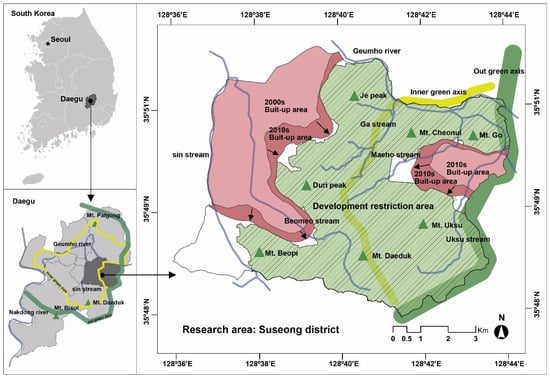
Figure 1.
Research area (slashed green areas are development restriction areas, red areas are built-up areas, a green line is planned out green axis and a yellow line is planned inner green axis).
The western part of Daegu’s downtown area and the eastern part of the country, which consists of residential areas, form an urbanized area and the hilly area between them is set as a development-restricted zone. However, over the past 30 years, urbanization has continued to expand around large-scale housing development projects and housing districts have been under development in areas adjacent to the development restricted areas. Over the past decade, the urbanized area has expanded by about 34.1% and, on the contrary, green areas continue to decline and, recently, pressure on the lifting of development-restricted zones has been increasing.
In consideration of this serious situation, local governments have implemented several greenhouse policies. In 2017, a park-green plan was proposed with the aim of 2030. Daegu Metropolitan City designates the development-restricted zone of this research site as a core area for preserving the green network. In particular, the plan aims to restore the disconnected ecological axis and link the fragmented parks and forests within the city. This plan, when implemented, is expected to have a significant effect on realizing a sustainable city. Therefore, analyzing the green network to identify green areas that need connection and conservation is essential for preserving biodiversity and sustainable urban development.
2.2. Research Framework
In this study, we selected (1) viable target species in urban areas for analysis of green network and distinguished the core green areas where target species can inhabit. (2) A least-cost path analysis was conducted considering the characteristics of the substrate surface and the cost weighted distance between green areas. (3) By analyzing the centrality, pinch-points and restoration opportunities using circuit theory, the relative importance of each green area, path and corridor was identified and areas requiring additional green space were identified. The overall research process is presented in Figure 2 and the following sub-chapter details each step.

Figure 2.
The research framework is divided into 3 Phases (CWD: cost-weighted distance LCD: least-cost distance, LCD′: restored least-cost distance).
2.2.1. Selection of Target Species and Extraction of Core Green Areas
In the case of this study, due to the spatial specificity of urban build-up area and natural area appearing together, we selected the target species that can enhance citizens’ aesthetic satisfaction along with the importance of preserving species. A total of 20 mammal species and 18 amphibian species were found to be emerging [34,35], but it was reported that there was little possibility of habitat and migration in urban areas, so it was limited to the target species for the establishment of green networks in urban areas [1,36]. However, birds can live in urban green areas, especially by creating a pleasant urban environment with their own appearance and sound, providing citizens with easy access to nature around their lives. In addition, birds are highly mobile and have active metabolism, which can immediately respond to environmental changes. Previous studies have shown 95 species of birds that have been confirmed to appear in the research area [37]. Among them, 12 species (Columba livia, Corvus corone, Dendrocopos leucotos, Eurystomus orientalis, Falco tinnunculus, Parus major, Passer montanus, Phasianus colchicus, Phoenicurus auroreus, Pica pica, Picus canus, Streptopelia orientalis) were selected as target species. This is because it is viable in cities and can be observed continuously by citizens throughout the year [38,39]. The target species mainly live in mountains near city, parks and they show the ecological characteristics of catching small seeds or insects in nearby farmland and open spaces [38,39,40,41]. These indicators are a good benchmark for species that effectively use the urban habitat and are motile at different spatial scales.
The core green areas where target species can be found were selected by reflecting the land use characteristics, minimum area standards and morphological characteristics. First, the selection of core green areas based on land use characteristics was based on the fact that small-sized grasshoppers lived evenly throughout Korea, but mainly in forests, rice paddies, fields and low hills. The minimum area standard for core green areas was set to 1 ha in this study by combining the prior study [42,43,44] on the habitat area of birds. In addition, in terms of morphology, the form of the core greenery was measured using the CIRCLE [45,46,47,48] among the landscape indices (Equation (1)).
CIRCLE = 1 − (ai/ais)
Where ai is the area of patch i. ais is the area of smallest circumscribing circle around patch i. CIRCLE’s range is 0 to 1. CIRCLE is 0 for circular patches. In addition, the value approaches 1 for elongated, linear patches. FRAGSTATS 4.2 was used to measure CIRCLE values and, as a result, green areas with values below 0.8 were selected as core green areas.
2.2.2. Least-Cost Path Analysis
For the analysis of the least-cost path, quantified data are needed to estimate the resistance of the target species depending on the characteristics of various substrate surfaces [28,29,49,50,51]. The cost to move the target species to habitat or an area rich in objects should be computerized. Here, the cost is affected by various landscape structures of a particular substrate plane due to natural and artificial factors [52]. The surface of the substrate between the core greenery may have factors that allow wild animals to move easily, or that hinder movement or change direction and the cost and resistance should be measured by considering the nature and arrangement of these factors.
The data used to prepare total resistance surfaces in this study are 1. biotope class, 2. NDVI (normalized difference vegetation index). First, the resistance values for each biotope class were set differently. In addition, the migration of the target species depends greatly on the vegetation density [29,53,54,55]. Vegetation density can vary even with the same biotope class. There may also be vegetative and non-vegetable areas within the biotope of urban areas. Therefore, NDVI was utilized to determine the distribution and density of each vegetation. NDVI uses data from 27 July 2017, which show the least interference of clouds among Landsat8 satellite images [56], taken over the past five years, to set weights by classifying them into three classes (Table 1).

Table 1.
NDVI classification for weight value.
Furthermore, since the least-cost path analysis is an analysis algorithm based on Raster data, it was necessary to convert resistance values in the form of vector data into Raster-based files [57]. Thus, in this work, we utilize the feature to raster function of ArcGIS 10.2 to convert the 30 m × 30 m cell size to a TIFF file to extract the resistance surface. The green network is identified by utilizing the analysis core greenery and resistance surface derived above. The analysis was conducted using Linkage Pathway to check the neighborhood between core green areas, analyze the least-cost path and analyze the connection path. First, the proximity between core green areas distinguished the substrate surface according to the nearest core green area on the distance and conducted Euclidean allocation, which only reflects the simple straight distance. If moving from one region to another must pass through another, it was determined that the two regions were not adjacent to each other. Leveraging these adjacency data, we exclude non-adjacent core green area pairs from the network configuration.
Next, the Linkage Pathway tool was used to analyze the cost weighted distance, the least-cost path and the connection path by reflecting the proximity data and resistance surface between the core green areas. The cost weighted distance represents the minimum value of the cumulative cost when the target species moves from the core greenery to the target point. Cost weighted distance maps written in this way provide estimates of relative access between each point and the closest core green areas and can be particularly useful in identifying areas that promote and inhibit wildlife migration [58]. The least-cost path analysis not only represents the most efficient path passing by the substrate plane between the base and the adjacent core greenery, but also analyzes cost weighted distance of the least-cost path by calculating the sum of all cost weighted distances on the path. The result is a relative comparison of each least-cost path, which enables the identification of areas with good connections and areas with poor connections. At this stage, the least-cost path from core green area A to B was automatically excluded if it passes through core green area C. The connection path analysis was previously analyzed by reflecting the cost weighted distance between the connected core green areas during the least-cost path analysis. The cumulative cost weighted distance value of the least-cost path and the cost weighted distance from a particular point to each core green area was derived to normalize the connecting path as shown below (Equation (2)).
where NLCCAB (Normalized Least-Cost Corridor) is the normalized connection between core green areas A and B, cost weighted distance (CWDA) is the cost weighted distance from core green areas A, CWDB is the cost weighted distance from core green areas B and LCDAB is the least-cost distance. Furthermore, the range of connecting path values starts with a value of zero, which means the optimal path. This process quantitatively identifies the reduced effectiveness of connectivity compared to the least-cost path and the derived route map can be useful for comparing the scope and effectiveness of the corridor area in establishing a green network. On the other hand, the existence of such a modeled connection path is not functionally connected but aims to present directions for further analysis and planning in the future.
NLCCAB = CWDA + CWDB − LCDAB
2.2.3. Analysis of Green Network Using Circuit Theory
This study conducted a central, pinch-point and restore opportunity analysis based on McRae’s circuit theory [59] to identify areas of high importance, areas of high potential mobility, areas of limited development, areas of greatest restoration effect and core green areas of significantly affect population growth. The definitions and ecological interpretations of the basic concepts of resistance, conductivity, current and voltage used in the circuit theory are shown in Table 2 [59].

Table 2.
Electrical terms and their ecological interpretations.
Centrality Mapper [60] was used for centrality analysis, in which each core green area was treated as a node and each link was assigned a resistance corresponding to the cost weighted distance of the least-cost path. When a network of nodes and links is complete, the Centrality Mapper uses Circuitscape [61] to calculate current flow centrality. Current flow centrality iteratively works on all core green area pairs to inject 1 Amp of current into one core region and set the other core region to ground. The current values flowing across all nodes and links were then summed to calculate the centrality score for each. Centrality was classified as Class 4 by the Quantile classification method, of which the top 10% of the upper classifications with the highest current flow-mediated centricity were highlighted and plotted.
A pinch-point is a point where mobility is concentrated within a corridor when the target species moves from habitat to substrate surface to other habitats. Generally, these points appear in the shape of a funnel and due to the highly concentrated flow of species, the impact of disturbance on overall connectivity is very high [59], i.e., difficult to replace the path, so even a small area loss can eventually pose a huge risk to the entire green network. To identify these pinch-points, Pinch-point Mapper [62] was utilized in this work. Pinch-point Mapper has the advantage of using Circuitscape to schematize current flow over core green area pairs connected directly to the least-cost path. An electric current of 1 Amp was injected from one core green area and the other was set to ground. The current then flows through the gangway area, setting the point where the flow of charges within the gangway area was concentrated as a pinch-point.
The Barrier Mapper [63] was used for restoration opportunity analysis. Barrier Mapper utilizes the results of the previous analysis of the green network using cost weighted distances. Restoration opportunities are derived by Equations (3) and (4) based on the assumption that the detection area has been restored to a type with a minimum resistance value.
LCD′ = CWDAMIN + CWDBMIN + (D × R′)
∆LCD = LCD − LCD′
LCD′ is the least-cost weighted distance through the center of the coverage area after removal and restoration of the barrier and CWDXMIN represents the least-cost weighted distance from the core green area X within the coverage area. D means the size of a particular area or diameter (50 m diameter in this study) and R′ means the adjusted resistance value (for this study, 1). The difference between the new least-cost weighted distance and the existing least-cost distance is defined as the opportunity to restore that pixel.
3. Results
3.1. Core Green Area Extraction
A total of 43 greenery were found as a result of core greenery extraction (Figure 3). The total area of 43 core green areas is about 36.18 km2, which is about 47.28% of the total area of the research site and 93.5% of the total green areas that are emerging within the research site. The core green area, which covers the largest area, is the No.9 green area, which covers an area of about 2156 ha.
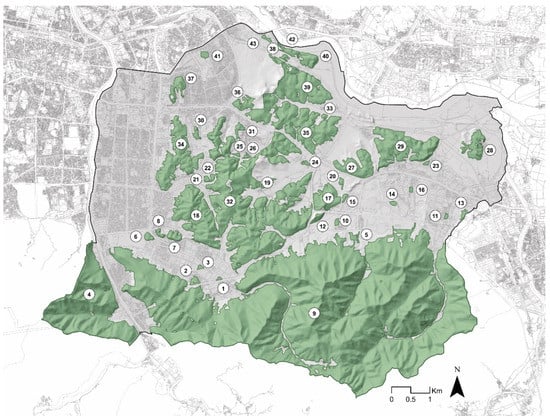
Figure 3.
Core green area.
Most of the core green areas with large areas are set up as development-restricted zones and green areas 6, 7, 8, 30 and 31 adjacent to the urbanized areas showed relatively narrow areas. This is believed to have caused the phenomenon of the fragmentation of green areas around the city center due to the disorderly expansion of the city. In addition, even large-scale green areas are cut due to inter-fat connection roads, which are expected to become more severe in the future. The results are like Forman’s claim that Korea’s development-restricted zones have recently been fragmented and cut into several large green spaces [1]. On the contrary, in the case of green areas No. 9 and 32, roads are passing by, but the area of green areas is maintained as it is constructed in the form of tunnels. As a result, the construction of roads was easing the fragmentation of green areas.
3.2. Least-Cost Path Analysis
3.2.1. Resistance Value and Resistance Surface Calculation
The following Figure 4 shows the total resistance values of the urban ecological status map and NDVI combined. The highest resistance value was set at 300 and was found to be mainly concentrated in overcrowded residential and commercial areas. Areas with relatively low resistance values were centered on development-restricted zones. On the other hand, green-rich educational facilities and parks were significantly lower resistance values than those in the surrounding areas. However, the isolation level of these areas is expected to be relatively high because some neighborhood parks in the city center, such as No. 37 and No. 41, which are set as core green areas, are showing a wide range of resistance values.
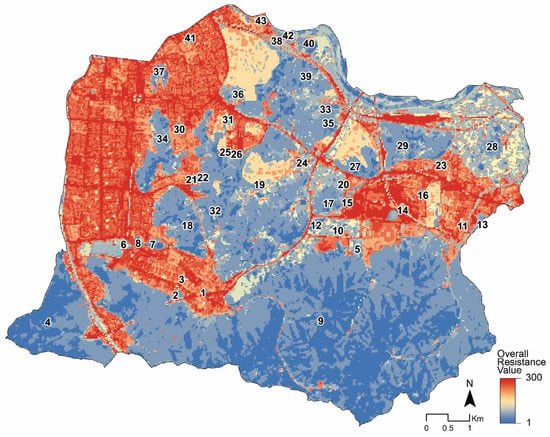
Figure 4.
Overall resistance value map (Red has a high resistance value and blue has a low resistance value. The minimum resistance is 1 and the maximum resistance is 300.).
The lowest resistance value in the core green area was 2.26, which was analyzed as No. 12. The area is considered to have a high density of vegetation due to the relatively large area of Quercus acutissima and Robinia pseudoacacia in the southeast, although the construction of roads in the northwest is undergoing slope recording. Conversely, the number 14 core green area had the highest average resistance value of 77.65 because it was used as a transportation island with a low density of vegetation on the highway.
3.2.2. Result of Proximity Allocation Analysis between Core Green Areas
A total of 117 pairs of neighbors were found to be adjacent, of which 109 were adjacent according to a simple straight line using Euclidean allocation and 107 were found to be adjacent using cost allocation reflecting the resistance surface (Table A1 in Appendix A).
For example, in the case of 11 cases, the simple direct election management was applied and found to be adjacent to a total of four regions, including 9, 13, 16 and 23. On the other hand, when applying cost weighted distances, it was analyzed that no. 16 and no. 23 of them were adjacent and also, areas 28 were found to be adjacent to a total of three regions (Figure 5). Using these results, it is believed that the overall connectivity of urban green networks can be efficiently enhanced and the effectiveness of the plan can be enhanced by preferentially securing the connectivity of pairs adjacent to but not to the cost.
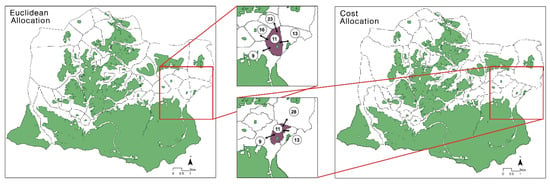
Figure 5.
Result of Euclidean allocation and cost allocation analysis of core green areas.
3.2.3. Least-Cost Distance, Least-Cost Path and Corridor Analysis Results
The results of cost distances and least-cost paths using the Linkage pathway are shown in Figure 6. The cost weighted distance is increasing as the market is getting bigger, especially in low-rise residential areas in the west. This area was mostly rice paddies and fields in the 1960s, but it seems that the value of the substrate surface has decreased in terms of ecology due to the reckless development.
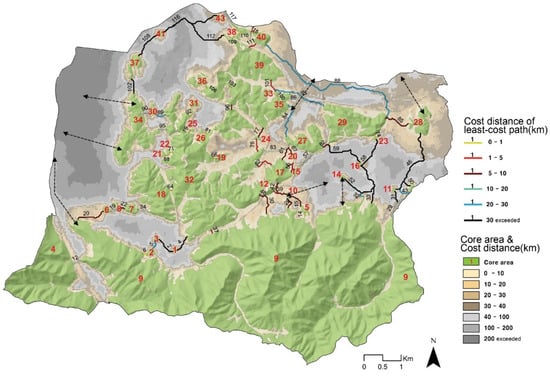
Figure 6.
Least-cost path & Cost weighted distance map (The least-cost paths shown in the figure represent only 69 out of 117 routes, excluding 48 passing through other core areas. The cost distance representing the core area to the point is shorter the yellow and the gray the cost distance is longer.).
On the other hand, we analyzed the least-cost paths for 117 core green area pairs previously derived from the analysis of proximity. In addition, a total of 69 least-cost paths were derived except for 48 routes passing other core green areas (Table A1). The least-cost path with the highest cost weighted distance is Route 112, which connects Area 39 and 41, with a total cost weighted distance of approximately 149.5 km and the actual length of the route is approximately 2.2 km. This is attributed to the absence of overcrowded residential areas and a wide range of road-enclosed planting spaces, with an average resistance of 68. In addition, most of the long-established routes with a cost weighted distance of more than 30 kilometers were penetrating the marketplace of the research site, while the least-cost path passing inside the development-restricted zone was low.
Most of the least-cost paths were also identified as utilizing natural streams and small green areas. For example (Figure 7), in the case of No. 57 least-cost path linking No. 15 to No. 27 core green, it was analyzed that it passed through the forests and rivers behind the baseball field. In addition, the 33rd least-cost path connecting No. 9 to No. 16 was passing through a small forest near the high school and the least-cost path connecting No. 1 to No. 32 was via Children’s Park. These results are judged to indicate the value of small green and linear green areas that were not previously selected in the target green area as connecting the core green area to the core green area.
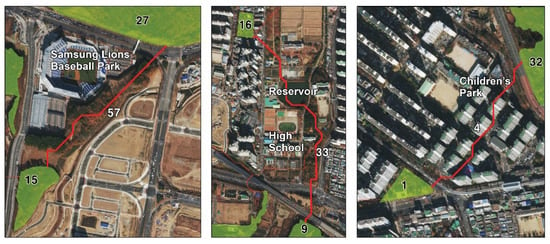
Figure 7.
Least-cost path through small green areas.
The least-cost corridor analysis results for verifying the extent and effectiveness of the gangway area are shown in Figure 8 below. A wide corridor with a lower cost than the least-cost corridor was formed around the wetlands and development-restricted zones around the Kumho River and a least-cost corridor was also found around the arable land near the No. 28 core green area. On the other hand, the corridor area across the street was quite narrow. Considering that the least-cost path and corridors are formed around the extrusion of the core green area, it is believed that extrusions of green areas are effective in attracting target species through the city to green areas. This shows significant similarities to the fence dispersion and fence effects of patches claimed by Forman [64].
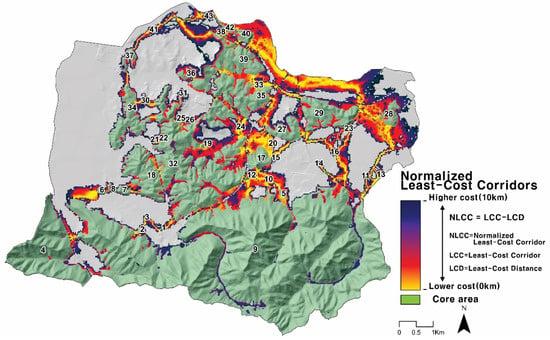
Figure 8.
Normalized least-cost corridors map (NLCC represents the distance from the least-cost path to that point. The navy has a longer cost distance away from the path and the yellow has a shorter cost distance.).
In addition to the least-cost path, corridor areas have been identified and these areas are particularly likely to be used as alternative routes. For example, the least-cost path between core green areas No. 16 and No. 23 was set to pass through high schools and elementary schools, but the least-cost corridor were derived using apartment landscaping green areas, small rivers and roadside buffer green areas (Figure 9). Areas where this alternative corridor can be established are considered extremely valuable in terms of preserving connectivity.
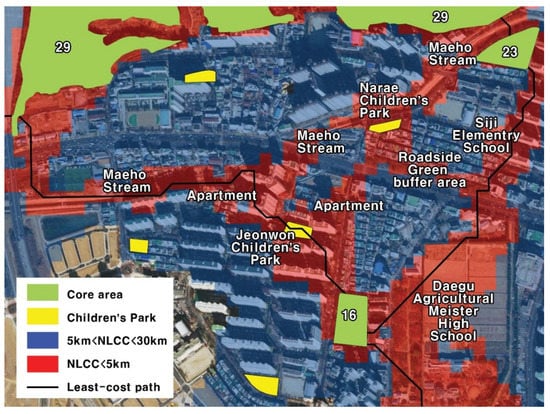
Figure 9.
Example of alternative corridor (NLCC: Normalized Least-Cost Corridor).
3.3. Centrality, Pinch-Point, Restoration Analysis
3.3.1. Centrality
The centrality analysis was conducted to distinguish the relatively high-importance areas and routes for increasing and preserving the population of the target species and strengthening the connectivity of the green network in the target green area and least-cost path. The results are shown in Figure 10 below.
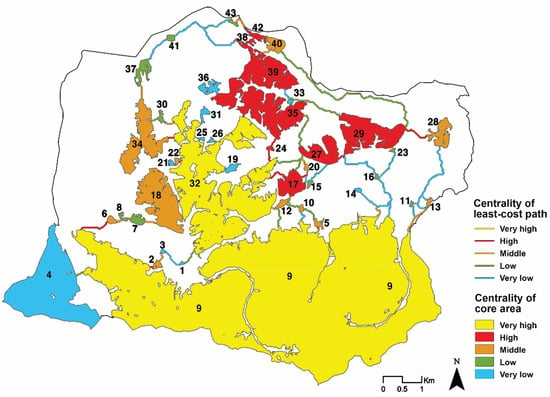
Figure 10.
Centrality of core area & least-cost path (it is classified into 5 grade: very high in yellow and very low in blue).
The highest centrality of the target green area was analyzed at 32. The results are believed to be since the No. 32 green areas are located in the center of the research site and 15 green areas, which account for about 35% of the total green area and the least-cost path. In addition, the area is in the middle of the development-restricted zone and is believed to have the highest centrality as the least-cost path connected to the surrounding green area shows a relatively low-cost distance compared to other routes. Next, the No.9 target green area, which is analyzed for its high centrality, is in the south of the research site with a large area and is connected to 11 target green areas and the least-cost path, which is shown to have high values. However, compared to Area 32, it is believed that the connected routes passed through the marketplace, resulting in several high-cost routes being connected, resulting in relatively low values. The development of areas with high centralities, such as areas 9 and 32, is feared to isolate the target species to sub-object groups, so it needs to be set as a conservation area. In addition, large areas such as 17, 27, 29, 35 and 39 with relatively higher centrality values than other areas are highly useful as core areas for establishing green networks for research sites in conjunction with Area 32. However, even areas with low or moderate centrality may perform important functions to maintain a sub-object group of target species. For example, Beomeo Park No. 34 had a moderate centrality analysis across the study site but considering that it was the only area connecting Yashigol Park to Hwarang Park No. 41, this area could be considered a critical area for maintaining the target species of the surrounding green area. These centrality analysis results can be the basis for establishing the hierarchy of axes in the future planning of green networks.
3.3.2. Pinch-Point
A pinch-point analysis was required to determine where the movement of target species within the gangway region is concentrated. The results of the pinch-point analysis are shown in Figure 11. Overall, the frequency of pinch-points within the marketplace was high and the result is that the high resistance of the marketplace narrowed the width of the aisle area and the possibility of creating alternative routes was also reduced.
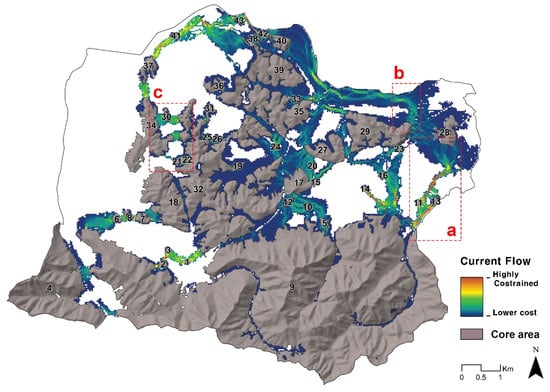
Figure 11.
Pinch-point map (the pinch-point area, where the current flow is concentrated, was expressed in red. The areas box (a–c) are expanded for illustration in Figure 12).
First, green areas 11, 13 and 14 were analyzed to be vulnerable to isolation as the width of the corridor connecting to the adjacent green areas was narrow and the movement of species within the corridor was concentrated at certain points. Looking at the flow leading to 9-11-13-28, we can see pinch-point in the small-scale forest and Wooksu stream behind the middle ground and the pinch-pint was mitigated (Figure 12a) by widening the gangway width outside the market. In addition, if you look at the flow from area 29 to the Kumho River, which is located north of the target site, you can see that the surrounding substrate surface is dominated by agricultural land, but the pinch-point occurs along Maeho Stream (Figure 3, Figure 4, Figure 5, Figure 6, Figure 7, Figure 8, Figure 9, Figure 10, Figure 11, Figure 12 and Figure 13b). In addition, to these reservoirs, the flow was found to be concentrated in the water purification plants near No. 5, 6, 10 and 12. It tells us that it is necessary to consider not only green but also water space together when planning a green network. If you look at the connections between 32 and 34, they are connected by corridor ①32-34, ②32-22-21-34, ③32-30-34 and the least-cost path is formed in corridor ① and ③ (Figure 3, Figure 4, Figure 5, Figure 6, Figure 7, Figure 8, Figure 9, Figure 10, Figure 11, Figure 12 and Figure 13c). However, the pinch-point is high in the case of the two corridor. Therefore, it is believed that increasing the amount of green near the corridor of ② will alleviate the pinch-point of corridor of ① and ③.
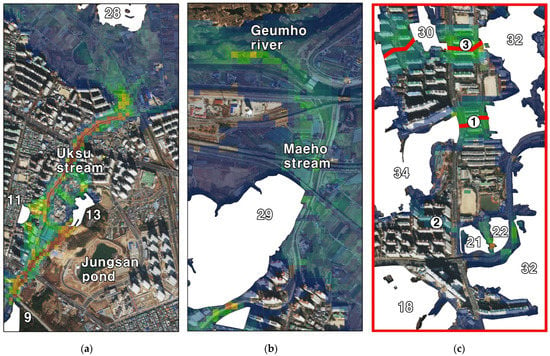
Figure 12.
Areas where pinch-point occur within the study (Box (a–c) part of Figure 11).
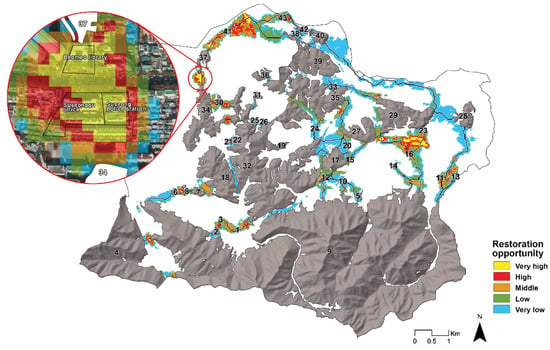
Figure 13.
Restoration opportunity map (Restoration opportunities were classified into five grades. Yellow is the area with No. 34 and 37 has been expanded as an example).
3.3.3. Restoration
Restoration opportunity analysis was conducted to identify areas that reduce the connectivity of green networks. The analysis results are shown in Figure 13 below. The area with the highest opportunity for restoration is the areas between No. 16 and No. 23. If green areas were to be increased, the least-cost distance could be reduced by up to 255 m. It was elucidated that if the street environment is improved as well as residential and commercial areas along DalguBeol road. This is expected to further strengthen the connectivity of green networks between the roadside park and Maeho Park, which lead to Daegu Agricultural Meister High School, DalguBeol road Street Green Area, Residential Area, Commercial Area and Shiji Elementary School.
In addition, if you look at the areas between No. 34 and No. 37, you can see that improvement of public facilities such as Suseonggu Office, Suseong Police Station and Suseong District Beomeo Library is needed first. In the case of public facilities, there is an advantage that the feasibility of policies is relatively high compared to private lands such as houses and shops. In addition, the public notice in the land of the Suseong District Beomeo Library is expected to be highly needed not only in terms of ecology but also in terms of providing a pleasant resting place for citizens through improvement. In addition, the strengthening of the green network in this area is expected to significantly reduce the isolation of green areas No. 37 and 41, which have a single corridor.
4. Discussion
Existing prior studies mainly used graph theory [65,66,67] and gravity model [9,68,69] to approach the linear level in evaluating the connectivity and network of urban green areas. However, the analysis results of the linear level were limited in the application of spatial planning and an approach attempt to the area level with clear boundaries is required to realize the green network plan [70]. To address this issue, this study aims to effectively use urban habitats, select motile species at various spatial scales and analyze urban green networks using circuit theory and least-cost distance methodology.
Studies have been conducted in many ways to find restoration areas, especially in cities, to develop ecological integrity [71,72]. Kong et al. points out that setting up the restoration area under the supervision of the planners is ineffective. It claims that it is necessary to establish a restoration area by quantified evaluation methods [9]. In this study, restoration opportunities were presented divided into five grades. In the research area, it was analyzed that increasing the amount of green areas on the roadside and the built-up area and public facilities between No. 16 and No. 23 would be the most effective. These results can be used to make budget decisions to establish green network. There is also a similarity to [73] in that the establishment of the restoration area should consider the proximity to the minimum cost path and the potential for development as alternative paths. On the other hand, a number of studies have been conducted to establish conservation areas of high biodiversity value for sustainable cities [74,75,76]. In order to establish these conservation areas, the method and results of the centrality analysis in this study can be referred to. According to the centrality analysis, green area No. 32 with the highest value could be selected as a conservation area first. In the case of No. 32, it can be interpreted that the target species in the outer part of the city serve as gatekeepers to enter the research area. We believe that if the field survey of the target species is conducted in the future, it will be possible to hypothesize that No. 32 has a higher variety of target species than other green areas. Research also showed that most of the least-cost paths and corridors were concentrated in development-restricted zones. This is in line with Korean studies focusing on the ecological value of the restricted development zone [77,78]. It is believed that it will provide a basis for securing the ecological value of the city in Korea, where the pressure to lift the restricted development zones has been increasing recently.
We believe that applying the quantitative methodology used in this study to a 10-year green network plan would be effective in determining the achievement rate of the plan. In addition, due to the characteristics of the analysis method, detailed variables such as habitat selection and resistance surface that are used as input data may vary when target species are applied differently, such as mammals and amphibians [79,80]. Subsequent analysis has the advantage of being able to automate. In particular, it is judged that this research can be utilized not only for improving connectivity but also for planning for reducing connectivity. For example, wild boars, rabbits and mice carrying germs could be used for space planning to prevent the invasion of harmful tides or infectious diseases [81,82].
In future studies, the results of the study can be verified by conducting a field survey to identify the species distribution of the target species. In addition, research can be conducted to explore the connectivity with the green network plan of wide-area units by performing analysis on various spatial scales.
5. Conclusions
In this study, we analyzed the green network using the least-cost distance and circuit theory for Suseong district, Daegu, South Korea. A total of 12 species of birds that can effectively use urban habitats and apply to various spaces are set as target species. A total of 43 core green areas were selected and the resistance surface considered the biotope type and NDVI. A total of 69 least-cost paths were derived. The least-cost paths were mainly through streams and small green areas. The corridors through the built-up areas was generally narrow, with high bottlenecks. The area with the highest centrality in the research area was found to be No. 32 green, located in the center. The area with the highest chance of restoration was the built-up area between No. 16 and No. 23. Previously, green networks were analyzed for urban areas, but our research was analyzed at the area level to make it easier to apply to spatial planning than previous studies. If the target species changes, the results can be different. Future researchers should consider conducting field surveys and comparing them with the results of this study.
Author Contributions
Conceptualization, O.-S.K. and J.-H.K.; methodology, O.-S.K.; validation, O.-S.K. and J.-H.K.; formal analysis, O.-S.K.; investigation, O.-S.K. and J.-H.K.; resources, J.-H.K.; data curation, O.-S.K. and J.-H.K.; writing, O.-S.K., J.-H.K. and J.-H.R.; supervision, J.-H.R.; project administration, J.-H.R. All authors have read and agreed to the published version of the manuscript.
Funding
This research received no external funding.
Conflicts of Interest
The authors declare no conflict of interest.
Appendix A

Table A1.
Analysis value for each link.
Table A1.
Analysis value for each link.
| Link ID | Core1 ID | Core2 ID | Link Type | Euc Dist | Lc Dist | eucAdj | cwdAdj | lcpLength | Cwd To EucRatio | Cwd To PathRatio | CF Centrality |
|---|---|---|---|---|---|---|---|---|---|---|---|
| 1 | 1 | 2 | −15 | 427 | 49,586.83 | 1 | 1 | 1458 | 116.13 | 34.01 | −1.00 |
| 2 | 1 | 3 | 1 | 455 | 46,337.44 | 1 | 1 | 531 | 101.84 | 87.26 | 26.41 |
| 3 | 1 | 9 | −15 | 360 | 39,549.96 | 1 | 1 | 1351 | 109.86 | 29.27 | −1.00 |
| 4 | 1 | 32 | 1 | 383 | 34,951.07 | 1 | 1 | 489 | 91.26 | 71.47 | 39.60 |
| 5 | 2 | 3 | 1 | 192 | 21,485.64 | 1 | 1 | 259 | 111.90 | 82.96 | 49.40 |
| 6 | 2 | 9 | 1 | 55 | 662.13 | 1 | 1 | 132 | 12.04 | 5.02 | 88.09 |
| 7 | 3 | 7 | −15 | 813 | 59,373.74 | 1 | 0 | 9536 | 73.03 | 6.23 | −1.00 |
| 8 | 3 | 9 | −15 | 422 | 23,019.02 | 1 | 1 | 634 | 54.55 | 36.31 | −1.00 |
| 9 | 3 | 18 | −15 | 546 | 41,261.89 | 1 | 1 | 8731 | 75.57 | 4.73 | −1.00 |
| 10 | 3 | 32 | −15 | 721 | 34,597.98 | 1 | 1 | 6845 | 47.99 | 5.05 | −1.00 |
| 11 | 4 | 6 | −15 | 1310 | 30,627.79 | 1 | 1 | 3311 | 23.38 | 9.25 | −1.00 |
| 12 | 4 | 9 | 1 | 200 | 19,709.54 | 1 | 1 | 247 | 98.55 | 79.80 | 42.00 |
| 13 | 4 | 34 | −15 | 2242 | 59,066.52 | 1 | 1 | 10,293 | 26.35 | 5.74 | −1.00 |
| 14 | 5 | 9 | 1 | 9 | 424.26 | 1 | 1 | 84 | 47.14 | 5.05 | 73.04 |
| 15 | 5 | 10 | 1 | 343 | 8204.04 | 1 | 1 | 494 | 23.92 | 16.61 | 38.30 |
| 16 | 5 | 14 | −15 | 1093 | 33,363.24 | 1 | 0 | 3443 | 30.52 | 9.69 | −1.00 |
| 17 | 5 | 15 | −15 | 804 | 23,489.91 | 1 | 0 | 6876 | 29.22 | 3.42 | −1.00 |
| 18 | 6 | 7 | −15 | 329 | 25,411.38 | 0 | 1 | 434 | 77.24 | 58.55 | −1.00 |
| 19 | 6 | 8 | 1 | 119 | 19,591.53 | 1 | 1 | 199 | 164.63 | 98.45 | 45.19 |
| 20 | 6 | 9 | 1 | 443 | 6476.65 | 1 | 1 | 836 | 14.62 | 7.75 | 73.31 |
| 21 | 6 | 34 | −15 | 1166 | 49,758.22 | 1 | 1 | 12,788 | 42.67 | 3.89 | −1.00 |
| 22 | 7 | 8 | 1 | 32 | 5157.72 | 1 | 1 | 102 | 161.18 | 50.57 | 49.49 |
| 23 | 7 | 9 | −15 | 761 | 25,339.91 | 1 | 1 | 3007 | 33.30 | 8.43 | −1.00 |
| 24 | 7 | 18 | 1 | 156 | 16,313.53 | 1 | 1 | 294 | 104.57 | 55.49 | 60.85 |
| 25 | 8 | 9 | −15 | 661 | 27,052.14 | 1 | 0 | 1296 | 40.93 | 20.87 | −1.00 |
| 26 | 8 | 18 | −15 | 390 | 22,073.38 | 1 | 1 | 794 | 56.60 | 27.80 | −1.00 |
| 27 | 8 | 34 | −15 | 1007 | 48,007.33 | 1 | 1 | 4964 | 47.67 | 9.67 | −1.00 |
| 28 | 9 | 10 | 1 | 200 | 9307.71 | 1 | 1 | 344 | 46.54 | 27.06 | 33.69 |
| 29 | 9 | 11 | 1 | 556 | 34,110.46 | 1 | 1 | 796 | 61.35 | 42.85 | 33.65 |
| 30 | 9 | 12 | 1 | 452 | 8455.22 | 1 | 1 | 542 | 18.71 | 15.60 | 40.14 |
| 31 | 9 | 13 | 1 | 729 | 14,020.21 | 1 | 1 | 888 | 19.23 | 15.79 | 61.01 |
| 32 | 9 | 14 | 1 | 534 | 25,154.02 | 1 | 1 | 786 | 47.10 | 32.00 | 44.87 |
| 33 | 9 | 16 | 1 | 801 | 39,102.04 | 1 | 1 | 1246 | 48.82 | 31.38 | 33.23 |
| 34 | 9 | 18 | −15 | 900 | 7228.08 | 0 | 1 | 2202 | 8.03 | 3.28 | −1.00 |
| 35 | 9 | 23 | −15 | 1548 | 38,873.07 | 0 | 1 | 6852 | 25.11 | 5.67 | −1.00 |
| 36 | 9 | 28 | −15 | 2190 | 46,525.61 | 0 | 1 | 8163 | 21.24 | 5.70 | −1.00 |
| 37 | 9 | 32 | 1 | 61 | 1176.40 | 1 | 1 | 102 | 19.29 | 11.53 | 273.40 |
| 38 | 9 | 34 | −15 | 1747 | 27,118.63 | 0 | 1 | 4156 | 15.52 | 6.53 | −1.00 |
| 39 | 10 | 12 | 1 | 336 | 3036.58 | 1 | 1 | 422 | 9.04 | 7.20 | 41.12 |
| 40 | 10 | 14 | −15 | 1392 | 43,109.00 | 0 | 1 | 4240 | 30.97 | 10.17 | −1.00 |
| 41 | 10 | 15 | −15 | 428 | 15,266.83 | 1 | 1 | 1411 | 35.67 | 10.82 | −1.00 |
| 42 | 10 | 17 | 1 | 294 | 8461.61 | 1 | 1 | 596 | 28.78 | 14.20 | 44.08 |
| 43 | 11 | 13 | 1 | 314 | 27,090.61 | 1 | 1 | 457 | 86.28 | 59.28 | 26.18 |
| 44 | 11 | 16 | −15 | 1023 | 76,854.59 | 1 | 0 | 2502 | 75.13 | 30.72 | −1.00 |
| 45 | 11 | 23 | −15 | 1334 | 54,662.86 | 1 | 0 | 3461 | 40.98 | 15.79 | −1.00 |
| 46 | 11 | 28 | 1 | 1559 | 46,982.81 | 0 | 1 | 2135 | 30.14 | 22.01 | 28.47 |
| 47 | 12 | 17 | 1 | 76 | 5314.26 | 1 | 1 | 132 | 69.92 | 40.26 | 60.27 |
| 48 | 12 | 32 | 1 | 92 | 6219.44 | 1 | 1 | 157 | 67.60 | 39.61 | 52.04 |
| 49 | 13 | 23 | −15 | 1490 | 55,002.92 | 1 | 0 | 3323 | 36.91 | 16.55 | −1.00 |
| 50 | 13 | 28 | 1 | 1333 | 47,322.86 | 1 | 1 | 1997 | 35.50 | 23.70 | 26.47 |
| 51 | 14 | 15 | −15 | 1084 | 52,881.01 | 1 | 1 | 9333 | 48.78 | 5.67 | −1.00 |
| 52 | 14 | 16 | 1 | 442 | 51,640.21 | 1 | 1 | 1823 | 116.83 | 28.33 | 25.48 |
| 53 | 14 | 27 | −15 | 827 | 54,795.02 | 1 | 1 | 9413 | 66.26 | 5.82 | −1.00 |
| 54 | 14 | 29 | −15 | 847 | 67,691.33 | 1 | 1 | 10,649 | 79.92 | 6.36 | −1.00 |
| 55 | 15 | 17 | 1 | 51 | 5374.26 | 1 | 1 | 132 | 105.38 | 40.71 | 35.17 |
| 56 | 15 | 20 | 1 | 128 | 6093.20 | 1 | 1 | 252 | 47.60 | 24.18 | 23.67 |
| 57 | 15 | 27 | 1 | 520 | 12,452.56 | 1 | 1 | 646 | 23.95 | 19.28 | 30.94 |
| 58 | 16 | 23 | 1 | 668 | 80,671.99 | 1 | 1 | 941 | 120.77 | 85.73 | 18.90 |
| 59 | 16 | 29 | 1 | 681 | 77,417.98 | 1 | 1 | 1264 | 113.68 | 61.25 | 19.54 |
| 60 | 17 | 20 | 1 | 145 | 1236.40 | 1 | 1 | 174 | 8.53 | 7.11 | 79.72 |
| 61 | 17 | 27 | 1 | 441 | 8491.46 | 1 | 1 | 506 | 19.26 | 16.78 | 41.96 |
| 62 | 17 | 32 | 1 | 45 | 4090.14 | 1 | 1 | 489 | 90.89 | 8.36 | 98.84 |
| 63 | 18 | 21 | −15 | 242 | 4890.73 | 1 | 1 | 1236 | 20.21 | 3.96 | −1.00 |
| 64 | 18 | 32 | 1 | 26 | 450.00 | 1 | 1 | 60 | 17.31 | 7.50 | 98.87 |
| 65 | 18 | 34 | −15 | 267 | 23,982.28 | 1 | 1 | 3062 | 89.82 | 7.83 | −1.00 |
| 66 | 19 | 32 | 1 | 33 | 210.00 | 1 | 1 | 60 | 6.36 | 3.50 | 42.00 |
| 67 | 20 | 27 | 1 | 164 | 8054.77 | 1 | 1 | 319 | 49.11 | 25.25 | 44.23 |
| 68 | 21 | 22 | 1 | 19 | 150.00 | 1 | 1 | 60 | 7.89 | 2.50 | 42.00 |
| 69 | 21 | 32 | −15 | 74 | 859.71 | 1 | 1 | 204 | 11.62 | 4.21 | −1.00 |
| 70 | 21 | 34 | −15 | 248 | 21,950.44 | 1 | 1 | 1820 | 88.51 | 12.06 | −1.00 |
| 71 | 22 | 32 | 1 | 28 | 540.00 | 1 | 1 | 60 | 19.29 | 9.00 | 82.00 |
| 72 | 22 | 34 | −15 | 354 | 21,630.73 | 1 | 1 | 1676 | 61.10 | 12.91 | −1.00 |
| 73 | 23 | 28 | −15 | 872 | 8755.62 | 1 | 1 | 1480 | 10.04 | 5.92 | −1.00 |
| 74 | 23 | 29 | 1 | 48 | 543.20 | 1 | 1 | 72 | 11.32 | 7.54 | 57.38 |
| 75 | 24 | 27 | −15 | 632 | 16,272.49 | 1 | 0 | 1259 | 25.75 | 12.92 | −1.00 |
| 76 | 24 | 32 | 1 | 187 | 2803.68 | 1 | 1 | 367 | 14.99 | 7.64 | 119.71 |
| 77 | 24 | 35 | 1 | 231 | 7159.30 | 1 | 1 | 289 | 30.99 | 24.77 | 101.67 |
| 78 | 25 | 26 | −15 | 78 | 2079.59 | 1 | 1 | 204 | 26.66 | 10.19 | −1.00 |
| 79 | 25 | 32 | 1 | 35 | 724.26 | 1 | 1 | 72 | 20.69 | 10.06 | 42.00 |
| 80 | 26 | 31 | −15 | 396 | 3906.76 | 1 | 1 | 1006 | 9.87 | 3.88 | −1.00 |
| 81 | 26 | 32 | 1 | 33 | 424.26 | 1 | 1 | 42 | 12.86 | 10.10 | 42.00 |
| 82 | 27 | 29 | 1 | 120 | 9906.24 | 1 | 1 | 174 | 82.55 | 56.93 | 86.43 |
| 83 | 27 | 32 | 1 | 584 | 13,082.89 | 1 | 1 | 849 | 22.40 | 15.41 | 43.12 |
| 84 | 27 | 35 | 1 | 514 | 20,349.66 | 1 | 1 | 1116 | 39.59 | 18.23 | 41.82 |
| 85 | 28 | 29 | 1 | 582 | 7160.10 | 1 | 1 | 761 | 12.30 | 9.41 | 74.68 |
| 86 | 29 | 35 | 1 | 882 | 17,681.61 | 1 | 1 | 1121 | 20.05 | 15.77 | 49.12 |
| 87 | 29 | 39 | 1 | 1339 | 21,374.10 | 1 | 0 | 1813 | 15.96 | 11.79 | 42.03 |
| 88 | 29 | 40 | 1 | 2258 | 24,784.57 | 1 | 0 | 4822 | 10.98 | 5.14 | 39.32 |
| 89 | 30 | 32 | 1 | 173 | 22,367.82 | 1 | 1 | 264 | 129.29 | 84.73 | 49.67 |
| 90 | 30 | 34 | 1 | 165 | 15,151.83 | 1 | 1 | 234 | 91.83 | 64.75 | 44.20 |
| 91 | 30 | 37 | −15 | 816 | 77,553.54 | 1 | 1 | 1276 | 95.04 | 60.78 | −1.00 |
| 92 | 31 | 32 | 1 | 38 | 543.20 | 1 | 1 | 72 | 14.29 | 7.54 | 42.00 |
| 93 | 31 | 36 | −15 | 306 | 19,511.79 | 1 | 1 | 4235 | 63.76 | 4.61 | −1.00 |
| 94 | 31 | 39 | −15 | 253 | 16,643.85 | 1 | 1 | 3663 | 65.79 | 4.54 | −1.00 |
| 95 | 32 | 34 | 1 | 158 | 17,100.00 | 1 | 1 | 210 | 108.23 | 81.43 | 72.46 |
| 96 | 32 | 35 | 1 | 70 | 5550.00 | 1 | 1 | 120 | 79.29 | 46.25 | 167.34 |
| 97 | 32 | 36 | −15 | 377 | 10,198.60 | 1 | 1 | 1730 | 27.05 | 5.90 | −1.00 |
| 98 | 32 | 37 | −15 | 1078 | 83,168.29 | 1 | 1 | 2336 | 77.15 | 35.60 | −1.00 |
| 99 | 32 | 39 | −15 | 282 | 7330.66 | 1 | 1 | 1158 | 26.00 | 6.33 | −1.00 |
| 100 | 33 | 35 | 1 | 19 | 212.13 | 1 | 1 | 42 | 11.16 | 5.05 | 53.41 |
| 101 | 33 | 39 | 1 | 270 | 3075.99 | 1 | 1 | 349 | 11.39 | 8.81 | 17.91 |
| 102 | 34 | 37 | 1 | 332 | 60,598.33 | 1 | 1 | 414 | 182.53 | 146.37 | 50.76 |
| 103 | 35 | 39 | 1 | 10 | 212.13 | 1 | 1 | 42 | 21.21 | 5.05 | 235.68 |
| 104 | 35 | 40 | −15 | 1035 | 4548.31 | 0 | 1 | 1351 | 4.39 | 3.37 | −1.00 |
| 105 | 36 | 37 | −15 | 1276 | 102,689.28 | 1 | 1 | 6571 | 80.48 | 15.63 | −1.00 |
| 106 | 36 | 39 | 1 | 12 | 127.28 | 1 | 1 | 42 | 10.61 | 3.03 | 42.00 |
| 107 | 36 | 41 | −15 | 1341 | 156,429.06 | 1 | 1 | 4460 | 116.65 | 35.07 | −1.00 |
| 108 | 37 | 41 | 1 | 722 | 84,507.27 | 1 | 1 | 821 | 117.05 | 102.93 | 35.35 |
| 109 | 38 | 39 | 1 | 36 | 724.26 | 1 | 1 | 72 | 20.12 | 10.06 | 126.40 |
| 110 | 38 | 42 | 1 | 51 | 724.26 | 1 | 1 | 72 | 14.20 | 10.06 | 102.72 |
| 111 | 39 | 40 | 1 | 151 | 2834.92 | 1 | 1 | 217 | 18.77 | 13.06 | 53.01 |
| 112 | 39 | 41 | 1 | 1571 | 149,454.09 | 1 | 1 | 2172 | 95.13 | 68.81 | 24.87 |
| 113 | 39 | 42 | −15 | 210 | 2297.06 | 1 | 1 | 302 | 10.94 | 7.61 | −1.00 |
| 114 | 39 | 43 | −15 | 307 | 18,560.35 | 1 | 1 | 978 | 60.46 | 18.98 | −1.00 |
| 115 | 40 | 42 | 1 | 12 | 1360.66 | 1 | 1 | 114 | 113.39 | 11.94 | 66.37 |
| 116 | 41 | 43 | 1 | 1458 | 140,899.64 | 1 | 1 | 1763 | 96.64 | 79.92 | 26.25 |
| 117 | 42 | 43 | 1 | 147 | 14,863.40 | 1 | 1 | 446 | 101.11 | 33.33 | 61.17 |
References
- Forman, R.T.T. Urban Ecology: Science of Cites, 1st ed.; Cambridge University Press: Cambridge, UK, 2014. [Google Scholar]
- Kang, S.; Kim, J.O. Morphological analysis of green infrastructure in the Seoul metropolitan area, South Korea. Landsc. Ecol. Eng. 2015, 11, 259–268. [Google Scholar] [CrossRef]
- Ra, J.H. Possibility and limitations of new framework of landscape ecology. J. Korean Inst. Landsc. Archit. 2005, 33, 45–70. [Google Scholar]
- Harris, L.D.; Scheck, J. From implications to applications: The dispersal corridor principle applied to the conservation of biological diversity. Nat. Conserv. 1991, 2, 189–220. [Google Scholar]
- Jongman, R. Ecological networks are an issue for all of us. J. Landsc. Ecol. 2008, 1, 7–13. [Google Scholar] [CrossRef] [Green Version]
- Niemelä, J.; Saarela, S.R.; Söderman, T.; Kopperoinen, L.; Yli-Pelkonen, V.; Väre, S.; Kotze, D.J. Using the ecosystem services approach for better planning and conservation of urban green spaces: A Finland case study. Biodivers. Conserv. 2010, 19, 3225–3243. [Google Scholar] [CrossRef]
- Wei, J.; Qian, J.; Tao, Y.; Hu, F.; Ou, W. Evaluating spatial priority of urban green infrastructure for urban sustainability in areas of rapid urbanization: A case study of Pukou in China. Sustainability 2018, 10, 327. [Google Scholar] [CrossRef] [Green Version]
- Huang, B.X.; Chiou, S.C.; Li, W.Y. Landscape Pattern and Ecological Network Structure in Urban Green Space Planning: A Case Study of Fuzhou City. Land 2021, 10, 769. [Google Scholar] [CrossRef]
- Kong, F.; Yin, H.; Nakagoshi, N.; Zong, Y. Urban green space network development for biodiversity conservation: Identification based on graph theory and gravity modeling. Landsc. Urban Plan. 2010, 95, 16–27. [Google Scholar] [CrossRef]
- Moseley, D.; Marzano, M.; Chetcuti, J.; Watts, K. Green networks for people: Application of a functional approach to support the planning and management of greenspace. Landsc. Urban Plan. 2013, 116, 1–12. [Google Scholar] [CrossRef]
- Sagong, J.H. Development of Landscape Ecological Green-Network Model in a Metropolitan. Ph.D. Thesis, Kyungpook National University, Daegu, Korea, 2004. [Google Scholar]
- Han, B.H.; Kwak, J.I.; Park, S.C.; Hur, J.Y. A study on planning of roadside green for enhancing urban green network. Korean J. Environ. Ecol. 2014, 28, 128–141. [Google Scholar] [CrossRef]
- Nowicki, P.; Bennett, G.; Middleton, D.; Rientjes, S.; Wolters, R. Perspectives on Ecological Networks; European Center of Nature Conservation: Arnhem, The Netherlands, 2006. [Google Scholar]
- Fahrig, L. Effects of habitat fragmentation on biodiversity. Annu. Rev. Ecol. Evol. Syst. 2003, 34, 487–515. [Google Scholar] [CrossRef] [Green Version]
- Etherington, T.R. Geographical isolation and invasion ecology. Prog. Phys. Geogr. 2015, 39, 697–710. [Google Scholar] [CrossRef]
- Ostfeld, R.S.; Glass, G.E.; Keesing, F. Spatial epidemiology: An emerging (or re-emerging) discipline. Trends Ecol. Evol. 2005, 20, 328–336. [Google Scholar] [CrossRef]
- Meentemeyer, R.K.; Haas, S.E.; Václavík, T. Landscape epidemiology of emerging infectious diseases in natural and human-altered ecosystems. Annu. Rev. Phytopathol. 2012, 50, 379–402. [Google Scholar] [CrossRef] [Green Version]
- Wilson, E.O.; MacArthur, R.H. The Theory of Island Biogeography; Princeton University Press: Princeton, NJ, USA, 1967. [Google Scholar]
- Forman, R.T.; Godron, M. Patches and structural components for a landscape ecology. BioScience 1981, 31, 733–740. [Google Scholar]
- Opdam, P.; van Dorp, D.T.; Ter Braak, D.J.F. The effect of isolation on the number of woodland birds in small woods in the Netherlands. J. Biogeogr. 1984, 11, 473–478. [Google Scholar] [CrossRef]
- Thomas, C.D.; Thomas, J.A.; Warren, M.S. Distributions of occupied and vacant butterfly habitats in fragmented landscapes. Oecologia 1992, 92, 563–567. [Google Scholar] [CrossRef]
- Taylor, P.D.; Fahrig, L.; Henein, K.; Merriam, G. Connectivity is a vital element of landscape structure. Oikos 1993, 68, 571–573. [Google Scholar] [CrossRef] [Green Version]
- Ricketts, T.H. The matrix matters: Effective isolation in fragmented landscapes. Am. Nat. 2001, 158, 87–99. [Google Scholar] [CrossRef]
- Warntz, W. Transportation, social physics, and the law of refraction. Prof. Geogr. 1957, 9, 2–7. [Google Scholar] [CrossRef]
- Chardon, J.P.; Adriaensen, F.; Matthysen, E. Incorporating landscape elements into a connectivity measure: A case study for the Speckled wood butterfly (Pararge aegeria L.). Landsc. Ecol. 2003, 18, 561–573. [Google Scholar] [CrossRef]
- Verbeylen, G.; De Bruyn, L.; Adriaensen, F.; Matthysen, E. Does matrix resistance influence red squirrel (Sciurus vulgaris L. 1758) distribution in an urban landscape? Landsc Ecol. 2003, 18, 791–805. [Google Scholar] [CrossRef]
- Etherington, T.R. Least-cost modelling and landscape ecology: Concepts, applications, and opportunities. Current Landscape Ecology Reports. 2016, 1, 40–53. [Google Scholar] [CrossRef] [Green Version]
- Balbi, M.; Petit, E.J.; Croci, S.; Nabucet, J.; Georges, R.; Madec, L.; Ernoult, A. Ecological relevance of least cost path analysis: An easy implementation method for landscape urban planning. J. Environ. Manag. 2019, 244, 61–68. [Google Scholar] [CrossRef]
- Blair, R.B. Land use and avian species diversity along an urban gradient. Ecol. Appl. 1996, 6, 506–519. [Google Scholar] [CrossRef]
- Hong, S.H.; Han, B.H.; Choi, S.H.; Sung, C.Y.; Lee, K.J. Planning an ecological network using the predicted movement paths of urban birds. Landsc. Ecol. Eng. 2013, 9, 165–174. [Google Scholar] [CrossRef]
- Meffert, P.J.; Dziock, F. The influence of urbanisation on diversity and trait composition of birds. Landsc. Ecol. 2013, 28, 943–957. [Google Scholar] [CrossRef]
- Sandström, U.G.; Angelstam, P.; Mikusiński, G. Ecological diversity of birds in relation to the structure of urban green space. Landsc. Urban Plan. 2006, 77, 39–53. [Google Scholar] [CrossRef]
- Mörtberg, U.; Wallentinus, H.G. Red-listed forest bird species in an urban environment—Assessment of green space corridors. Landsc. Urban Plan. 2000, 50, 215–226. [Google Scholar] [CrossRef]
- Ministry of Environment. 2nd National Natural Environment Survey Report; Ministry of Environment: Gwacheon, Korea, 2000.
- Ministry of Environment. 3rd National Natural Environment Survey Report; Ministry of Environment: Gwacheon, Korea, 2009.
- Šálek, M.; Drahníková, L.; Tkadlec, E. Changes in home range sizes and population densities of carnivore species along the natural to urban habitat gradient. Mammal Rev. 2015, 45, 1–14. [Google Scholar] [CrossRef]
- Park, C.R.; Choi, M.S. Comparison of bird communities at urban forests and streetscapes in Daegu city. Korean J. Environ. Ecol. 2005, 19, 367–374. [Google Scholar]
- Yun, M.B. Resident Bird of Korea; Daewonsa: Seoul, Korea, 1993. [Google Scholar]
- Summers-Smith, J.D. The Sparrows: A Study of the Genus Passer; T & AD Poyser: Staffordshier, UK, 1988. [Google Scholar]
- Groschupf, K. Old World Sparrows. In The Sibley Guide to Bird Life and Behavior, 1st ed.; Elphick, C., Dunning, J.B., Sibley, D.A., Eds.; Alfred A. Knopf: New York City, NY, USA, 2000; pp. 562–564. [Google Scholar]
- Campbell, B.; Lack, E. A Dictionary of Birds; A&C Black: London, UK, 1985. [Google Scholar]
- Wilcox, B.A. In situ conservation of genetic resources: Determinants of minimum area requirements. In National Parks, Conservation and Development: The Role of Protected Areas in Sustaining Society; McNeely, J.A., Miller, K., Eds.; Smithsonian Institution Press: Washington, DC, USA, 1984; pp. 639–647. [Google Scholar]
- Kohn, D.D.; Walsh, D.M. Plant species richness—The effect of island size and habitat diversity. J. Ecol. 1994, 82, 367–377. [Google Scholar] [CrossRef]
- Riess, W. Konzepte zum Biotopverbund im Arten-und Biotopschutzprogramm Bayern. Lauf. Semin. 1986, 10, 102–115. [Google Scholar]
- Baker, W.L.; Cai, Y. The r.le programs for multiscale analysis of landscape structure using the GRASS geographical information system. Landsc. Ecol. 1992, 7, 291–302. [Google Scholar] [CrossRef]
- McGarigal, K. FRAGSTATS: Spatial Pattern Analysis Program for Quantifying Landscape Structure; US Department of Agriculture, Forest Service, Pacific Northwest Research Station: Portland, OR, USA, 1995.
- Matte, A.L.L.; Müller, S.C.; Becker, F.G. Forest expansion or fragmentation? Discriminating forest fragments from natural forest patches through patch structure and spatial context metrics. Austral Ecol. 2015, 40, 21–31. [Google Scholar] [CrossRef]
- Alphan, H.; Çelik, N. Monitoring changes in landscape pattern: Use of Ikonos and Quickbird images. Environ. Monit. Assess. 2016, 188, 81. [Google Scholar] [CrossRef]
- Singleton, P.H. Landscape Permeability for Large Carnivores in Washington: A Geographic Information System Weighted-Distance and Least-Cost Corridor Assessment; US Department of Agriculture, Forest Service: Portland, OR, USA, 2002; Volume 549.
- Adrensen, F.; Chardon, J.P.; De Blust, G.; Swinnen, E.; Villalba, S.; Gulinck, H.; Mattysen, E. The application of ‘least-cost’modelling as a functional landscape model. Landsc. Urban Plan. 2003, 64, 233–247. [Google Scholar] [CrossRef]
- Belote, R.T.; Dietz, M.S.; McRae, B.H.; Theobald, D.M.; McClure, M.L.; Urwin, G.H.; Aplete, G.H. Identifying corridors among large protected areas in the United States. PLoS ONE 2016, 11, e0154223. [Google Scholar] [CrossRef] [Green Version]
- Penrod, K.; Cabañero, C.; Beier, P.; Luke, C.; Spencer, W.; Rubin, E.; Remson, E. South Coast Missing Linkages Project: A Linkage Design for the Santa Monica-Sierra Madre Connection; South Coast Wildlands: Idyllwild, CA, USA, 2006. [Google Scholar]
- Tremblay, M.A.; St. Clair, C.C. Permeability of a heterogeneous urban landscape to the movements of forest songbirds. J. Appl. Ecol. 2011, 48, 679–688. [Google Scholar] [CrossRef]
- Shimazaki, A.; Yamaura, Y.; Senzaki, M.; Yabuhara, Y.; Akasaka, T.; Nakamura, F. Urban permeability for birds: An approach combining mobbing-call experiments and circuit theory. Urban For. Urban Green. 2016, 19, 167–175. [Google Scholar] [CrossRef]
- Watts, K.; Eycott, A.E.; Handley, P.; Ray, D.; Humphrey, J.W.; Quine, C.P. Targeting and evaluating biodiversity conservation action within fragmented landscapes: An approach based on generic focal species and least-cost networks. Landsc. Ecol. 2010, 25, 1305–1318. [Google Scholar] [CrossRef]
- United States Geological Survey (USGS). Available online: http://earthexplorer.usgs.gov (accessed on 7 May 2020).
- Daegu Map Portal. Available online: http://gis.go.kr (accessed on 27 April 2020).
- Singleton, P.H.; Gaines, W.L.; Lehmkuhl, J.F. Landscape permeability for grizzly bear movements in Washington and southwestern British Columbia. Ursus 2004, 15, 90–103. [Google Scholar] [CrossRef]
- McRae, B.H.; Dickson, B.G.; Keitt, T.H.; Shah, V.B. Using circuit theory to model connectivity in ecology, evolution, and conservation. Ecology 2008, 89, 2712–2724. [Google Scholar] [CrossRef]
- McRae, B.H. Centrality Mapper Connectivity Analysis Software; The Nature Conservcancy: Seattle, WA, USA, 2012; Available online: http://www.circuitscape.org/linkagemapper (accessed on 11 May 2020).
- McRae, B.H.; Shah, V.B. Circuitscape User’s Guide; The University of California: Snata Babara, CA, USA, 2009. [Google Scholar]
- McRae, B.H. Pinchpoint Mapper Connectivity Analysis Software; The Nature Conservancy: Seattle, WA, USA, 2012; Available online: http://www.circuitscape.org/linkagemapper (accessed on 11 May 2020).
- McRae, B.H. Barrier Mapper Connectivity Analysis Software; The Nature Conservancy: Seattle, WA, USA, 2012; Available online: http://www.circuitscape.org/linkagemapper (accessed on 11 May 2020).
- Forman, R.T. Land Mosaics: The Ecology of Landscape and Regions; Island Press: Washington DC, USA, 1995. [Google Scholar]
- Bunn, A.G.; Urban, D.L.; Keitt, T.H. Landscape connectivity: A conservation application of graph theory. J. Environ. Manag. 2000, 59, 265–278. [Google Scholar] [CrossRef] [Green Version]
- Zetterberg, A.; Mörtberg, U.M.; Balfors, B. Making graph theory operational for landscape ecological assessments, planning, and design. Landsc. Urban Plan. 2010, 95, 181–191. [Google Scholar] [CrossRef]
- Arif, K.; Afzal, Z.; Nadeem, M.; Ahmad, B.; Mahmood, A.; Iqbal, M.; Nazir, A. Role of graph theory to facilitate landscape connectivity: Subdivision of a Harary graph. Pol. J. Environ. Stud. 2018, 27, 993–999. [Google Scholar] [CrossRef]
- Rudd, H.; Vala, J.; Schaefer, V. Importance of backyard habitat in a comprehensive biodiversity conservation strategy: A connectivity analysis of urban green spaces. Restor. Ecol. 2002, 10, 368–375. [Google Scholar] [CrossRef] [Green Version]
- Yang, H.; Chen, W.; Chen, X. Regional Ecological Network Planning for Biodiversity Conservation: A Case Study of China’s Poyang Lake Eco-Economic Region. Pol. J. Environ. Stud. 2017, 26, 1825–1833. [Google Scholar] [CrossRef]
- Pelorosso, R.; Gobattoni, F.; Geri, F.; Monaco, R.; Leone, A. Evaluation of Ecosystem Services related to Bio-Energy Landscape Connectivity (BELC) for land use decision making across different planning scales. Ecol. Indic. 2016, 61, 114–129. [Google Scholar] [CrossRef]
- de Souza Leite, M.; Tambosi, L.R.; Romitelli, I.; Metzger, J.P. Landscape ecology perspective in restoration projects for biodiversity conservation: A review. Nat. Conserv. 2013, 11, 108–118. [Google Scholar] [CrossRef]
- Klaus, V.H.; Kiehl, K. A conceptual framework for urban ecological restoration and rehabilitation. Basic Appl. Ecol. 2021, 52, 82–94. [Google Scholar] [CrossRef]
- Hou, W.; Zhai, L.; Feng, S.; Walz, U. Restoration priority assessment of coal mining brownfields from the perspective of enhancing the connectivity of green infrastructure networks. J. Environ. Manag. 2021, 277, 111289. [Google Scholar] [CrossRef] [PubMed]
- Hermoso, V.; Villero, D.; Clavero, M.; Brotons, L. Spatial prioritisation of EU’s LIFE-Nature programme to strengthen the conservation impact of Natura 2000. J. Appl. Ecol. 2018, 55, 1575–1582. [Google Scholar] [CrossRef] [Green Version]
- Srinivasulu, A.; Srinivasulu, B.; Srinivasulu, C. Ecological niche modelling for the conservation of endemic threatened squamates (lizards and snakes) in the Western Ghats. Glob. Ecol. Conserv. 2021, 28, e01700. [Google Scholar] [CrossRef]
- Verhagen, W.; Kukkala, A.S.; Moilanen, A.; van Teeffelen, A.J.; Verburg, P.H. Use of demand for and spatial flow of ecosystem services to identify priority areas. Conserv. Biol. 2017, 31, 860–871. [Google Scholar] [CrossRef]
- Lee, S.W. The impacts of greenbelt policies on anti-sprawl. J. Korea Plan. Assoc. 2018, 53, 45–65. [Google Scholar] [CrossRef] [Green Version]
- Ryu, D.H.; Lee, D.K. Evaluation on economic value of the greenbelt’s ecosystem services in the Seoul metropolitan region. J. Korea Plan. Assoc. 2013, 48, 279–292. [Google Scholar]
- Merrick, M.J.; Koprowski, J.L. Circuit theory to estimate natal dispersal routes and functional landscape connectivity for an endangered small mammal. Landsc. Ecol. 2017, 32, 1163–1179. [Google Scholar] [CrossRef]
- Campos, F.S.; Lourenço-de-Moraes, R.; Ruas, D.S.; Mira-Mendes, C.V.; Franch, M.; Llorente, G.A.; Cabral, P. Searching for networks: Ecological connectivity for amphibians under climate change. Environ. Manag. 2020, 65, 46–61. [Google Scholar] [CrossRef]
- Saito, M.; Momose, H.; Mihira, T. Both environmental factors and countermeasures affect wild boar damage to rice paddies in Boso Peninsula, Japan. Crop Prot. 2011, 30, 1048–1054. [Google Scholar] [CrossRef]
- Herrera, J.; Nunn, C.L. Behavioural ecology and infectious disease: Implications for conservation of biodiversity. Philos. Trans. R. Soc. B 2019, 374, 20180054. [Google Scholar] [CrossRef] [Green Version]
Publisher’s Note: MDPI stays neutral with regard to jurisdictional claims in published maps and institutional affiliations. |
© 2021 by the authors. Licensee MDPI, Basel, Switzerland. This article is an open access article distributed under the terms and conditions of the Creative Commons Attribution (CC BY) license (https://creativecommons.org/licenses/by/4.0/).